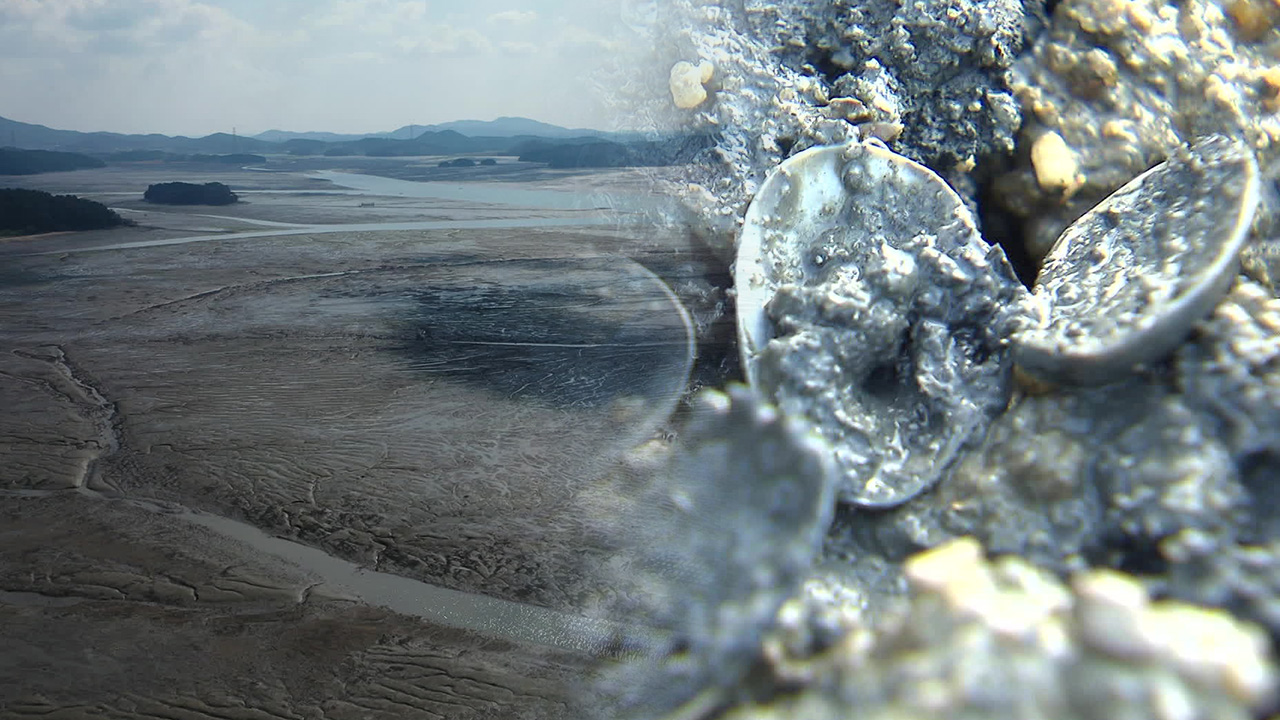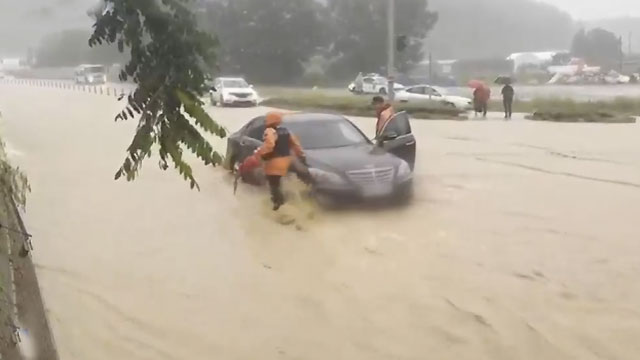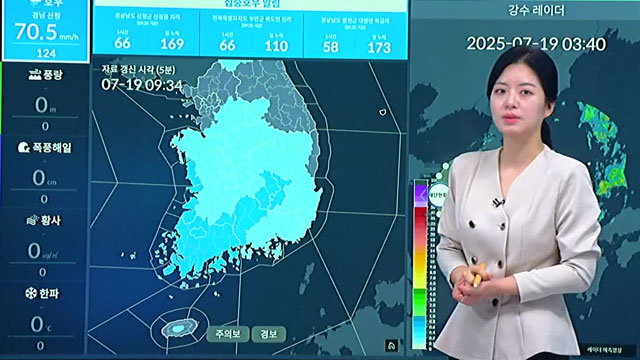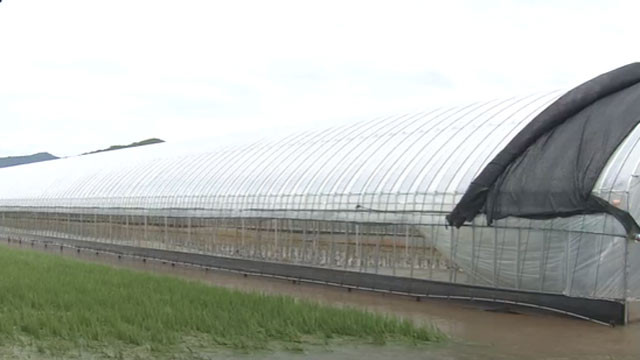More than 80% of clams have died: Is high temperature the cause?
입력 2024.10.13 (00:13)
읽어주기 기능은 크롬기반의
브라우저에서만 사용하실 수 있습니다.
[Anchor]
In the Garorim Bay of Seosan, Chungnam Province, known for its rich seafood, farmed clams have experienced mass die-offs.
The seasonal mud octopus has also disappeared, leaving fishermen in distress.
This is presumed to be due to the unusual high-temperature phenomenon experienced last summer.
Reporter Park Byeong-jun visited the site.
[Report]
Garorim Bay, one of the top clam-producing areas in the country, is unusually quiet this year, where clam harvesting would typically be bustling.
In places where dozens of clams would spill out with just a few strokes of a hoe, this year, only empty shells are found when scraping the mudflats.
["The population has clearly decreased. They are all rotten, so there’s no marketability."]
Even the clams that look fine are filled with mud inside, and those that are still alive are less than half the size of a normal year.
Although the harvesting season has begun, it is estimated that over 80% of the clams in this fishing village have died.
The area of the farms reporting such damage exceeds 670 hectares, accounting for 78% of all clam farms in the Seosan region.
The mud octopus and lugworms, which are additional sources of income for fishermen in the fall, have also disappeared by over 90%.
[Park Jong-il/Secretary of the Jungwang Fishing Village in Seosan: "Even when going deep, there’s nothing. Those who used to catch about 50 are now catching only three, four, or five. So they are not even going out to work at all."]
The unusual high temperatures last summer are suspected to be the cause.
In this area, a high-temperature warning of over 28 degrees has lasted for nearly two months.
[Song Jin-sik/Director of Marine and Fisheries Department in Seosan: "We suspect that high temperatures are the cause, and we are currently looking for ways to provide support."]
In the nearby sea area of Cheonsu Bay, the death of 6.4 million rockfish has also been reported, raising concerns about rising seafood prices.
KBS News, Park Byeong-jun.
In the Garorim Bay of Seosan, Chungnam Province, known for its rich seafood, farmed clams have experienced mass die-offs.
The seasonal mud octopus has also disappeared, leaving fishermen in distress.
This is presumed to be due to the unusual high-temperature phenomenon experienced last summer.
Reporter Park Byeong-jun visited the site.
[Report]
Garorim Bay, one of the top clam-producing areas in the country, is unusually quiet this year, where clam harvesting would typically be bustling.
In places where dozens of clams would spill out with just a few strokes of a hoe, this year, only empty shells are found when scraping the mudflats.
["The population has clearly decreased. They are all rotten, so there’s no marketability."]
Even the clams that look fine are filled with mud inside, and those that are still alive are less than half the size of a normal year.
Although the harvesting season has begun, it is estimated that over 80% of the clams in this fishing village have died.
The area of the farms reporting such damage exceeds 670 hectares, accounting for 78% of all clam farms in the Seosan region.
The mud octopus and lugworms, which are additional sources of income for fishermen in the fall, have also disappeared by over 90%.
[Park Jong-il/Secretary of the Jungwang Fishing Village in Seosan: "Even when going deep, there’s nothing. Those who used to catch about 50 are now catching only three, four, or five. So they are not even going out to work at all."]
The unusual high temperatures last summer are suspected to be the cause.
In this area, a high-temperature warning of over 28 degrees has lasted for nearly two months.
[Song Jin-sik/Director of Marine and Fisheries Department in Seosan: "We suspect that high temperatures are the cause, and we are currently looking for ways to provide support."]
In the nearby sea area of Cheonsu Bay, the death of 6.4 million rockfish has also been reported, raising concerns about rising seafood prices.
KBS News, Park Byeong-jun.
■ 제보하기
▷ 카카오톡 : 'KBS제보' 검색, 채널 추가
▷ 전화 : 02-781-1234, 4444
▷ 이메일 : kbs1234@kbs.co.kr
▷ 유튜브, 네이버, 카카오에서도 KBS뉴스를 구독해주세요!
- More than 80% of clams have died: Is high temperature the cause?
-
- 입력 2024-10-13 00:13:34

[Anchor]
In the Garorim Bay of Seosan, Chungnam Province, known for its rich seafood, farmed clams have experienced mass die-offs.
The seasonal mud octopus has also disappeared, leaving fishermen in distress.
This is presumed to be due to the unusual high-temperature phenomenon experienced last summer.
Reporter Park Byeong-jun visited the site.
[Report]
Garorim Bay, one of the top clam-producing areas in the country, is unusually quiet this year, where clam harvesting would typically be bustling.
In places where dozens of clams would spill out with just a few strokes of a hoe, this year, only empty shells are found when scraping the mudflats.
["The population has clearly decreased. They are all rotten, so there’s no marketability."]
Even the clams that look fine are filled with mud inside, and those that are still alive are less than half the size of a normal year.
Although the harvesting season has begun, it is estimated that over 80% of the clams in this fishing village have died.
The area of the farms reporting such damage exceeds 670 hectares, accounting for 78% of all clam farms in the Seosan region.
The mud octopus and lugworms, which are additional sources of income for fishermen in the fall, have also disappeared by over 90%.
[Park Jong-il/Secretary of the Jungwang Fishing Village in Seosan: "Even when going deep, there’s nothing. Those who used to catch about 50 are now catching only three, four, or five. So they are not even going out to work at all."]
The unusual high temperatures last summer are suspected to be the cause.
In this area, a high-temperature warning of over 28 degrees has lasted for nearly two months.
[Song Jin-sik/Director of Marine and Fisheries Department in Seosan: "We suspect that high temperatures are the cause, and we are currently looking for ways to provide support."]
In the nearby sea area of Cheonsu Bay, the death of 6.4 million rockfish has also been reported, raising concerns about rising seafood prices.
KBS News, Park Byeong-jun.
In the Garorim Bay of Seosan, Chungnam Province, known for its rich seafood, farmed clams have experienced mass die-offs.
The seasonal mud octopus has also disappeared, leaving fishermen in distress.
This is presumed to be due to the unusual high-temperature phenomenon experienced last summer.
Reporter Park Byeong-jun visited the site.
[Report]
Garorim Bay, one of the top clam-producing areas in the country, is unusually quiet this year, where clam harvesting would typically be bustling.
In places where dozens of clams would spill out with just a few strokes of a hoe, this year, only empty shells are found when scraping the mudflats.
["The population has clearly decreased. They are all rotten, so there’s no marketability."]
Even the clams that look fine are filled with mud inside, and those that are still alive are less than half the size of a normal year.
Although the harvesting season has begun, it is estimated that over 80% of the clams in this fishing village have died.
The area of the farms reporting such damage exceeds 670 hectares, accounting for 78% of all clam farms in the Seosan region.
The mud octopus and lugworms, which are additional sources of income for fishermen in the fall, have also disappeared by over 90%.
[Park Jong-il/Secretary of the Jungwang Fishing Village in Seosan: "Even when going deep, there’s nothing. Those who used to catch about 50 are now catching only three, four, or five. So they are not even going out to work at all."]
The unusual high temperatures last summer are suspected to be the cause.
In this area, a high-temperature warning of over 28 degrees has lasted for nearly two months.
[Song Jin-sik/Director of Marine and Fisheries Department in Seosan: "We suspect that high temperatures are the cause, and we are currently looking for ways to provide support."]
In the nearby sea area of Cheonsu Bay, the death of 6.4 million rockfish has also been reported, raising concerns about rising seafood prices.
KBS News, Park Byeong-jun.
-
-

박병준 기자 lol@kbs.co.kr
박병준 기자의 기사 모음
-
이 기사가 좋으셨다면
-
좋아요
0
-
응원해요
0
-
후속 원해요
0















이 기사에 대한 의견을 남겨주세요.